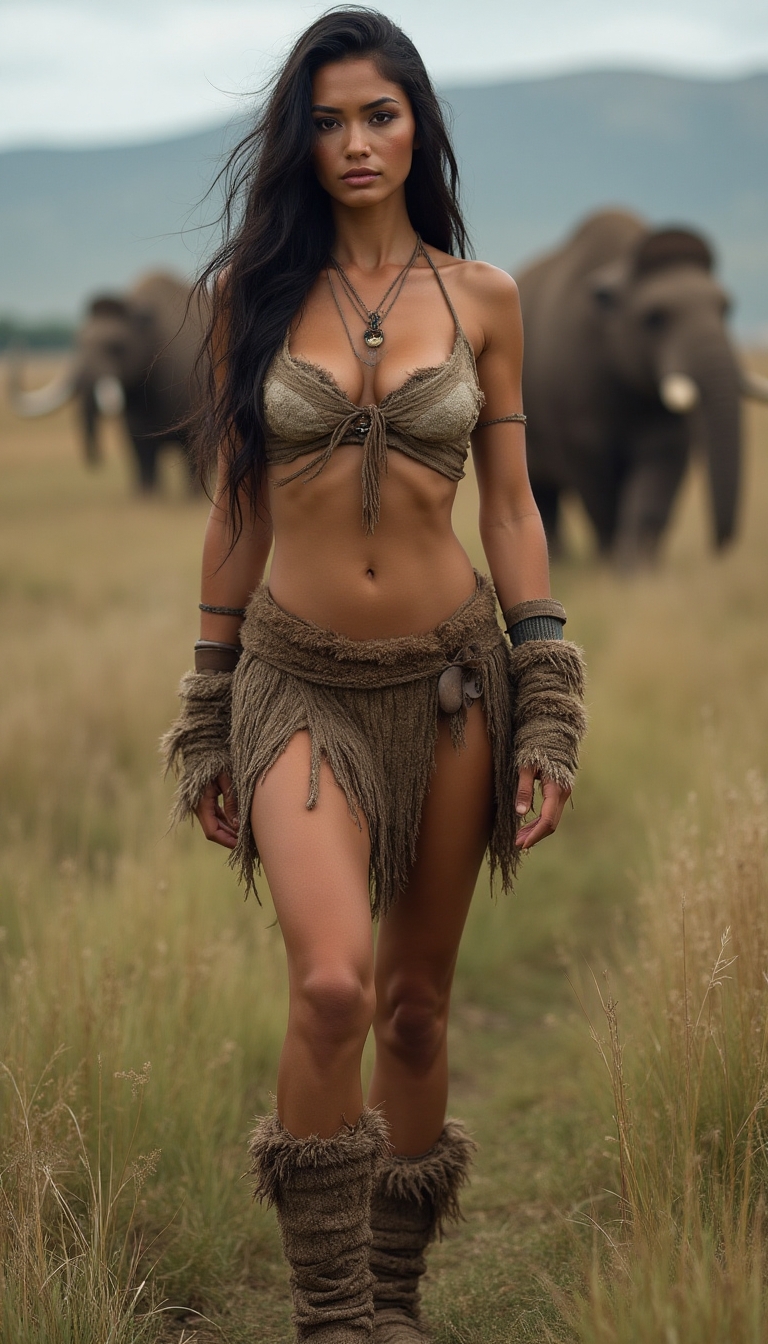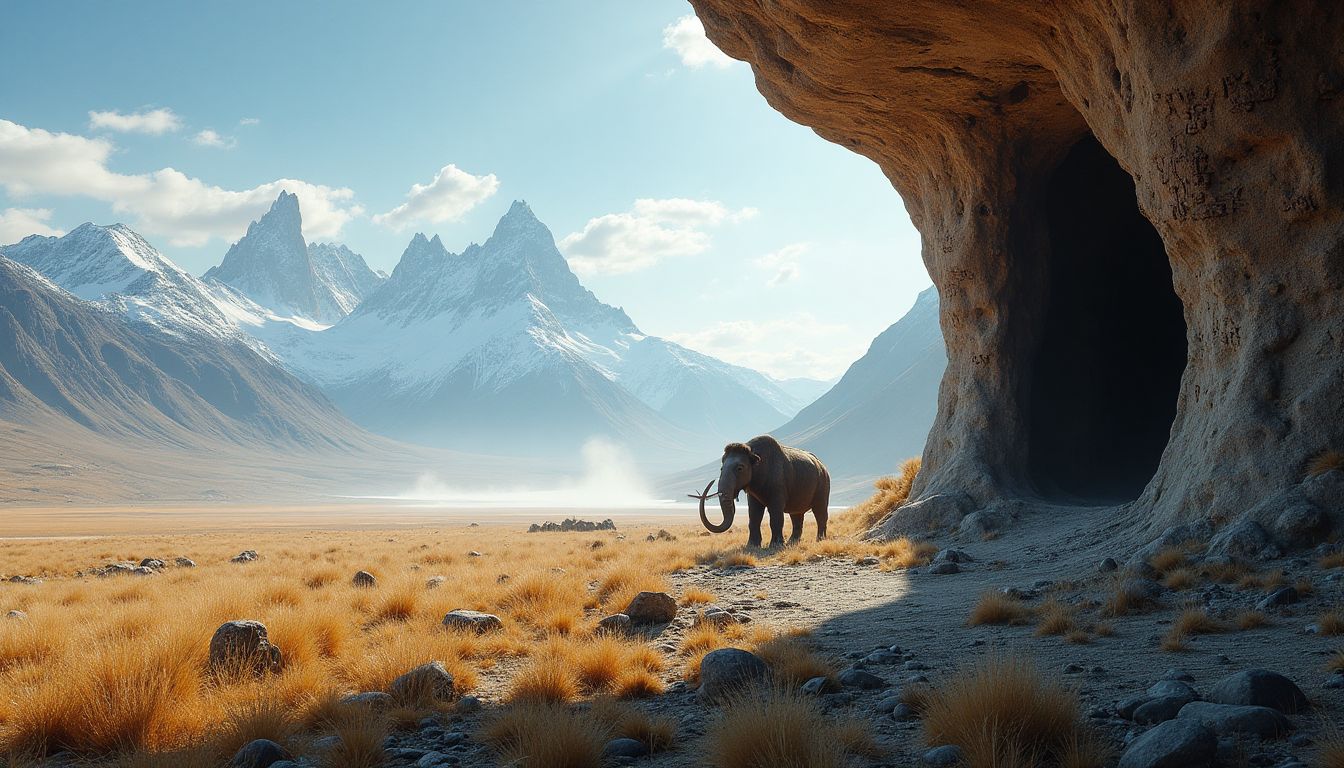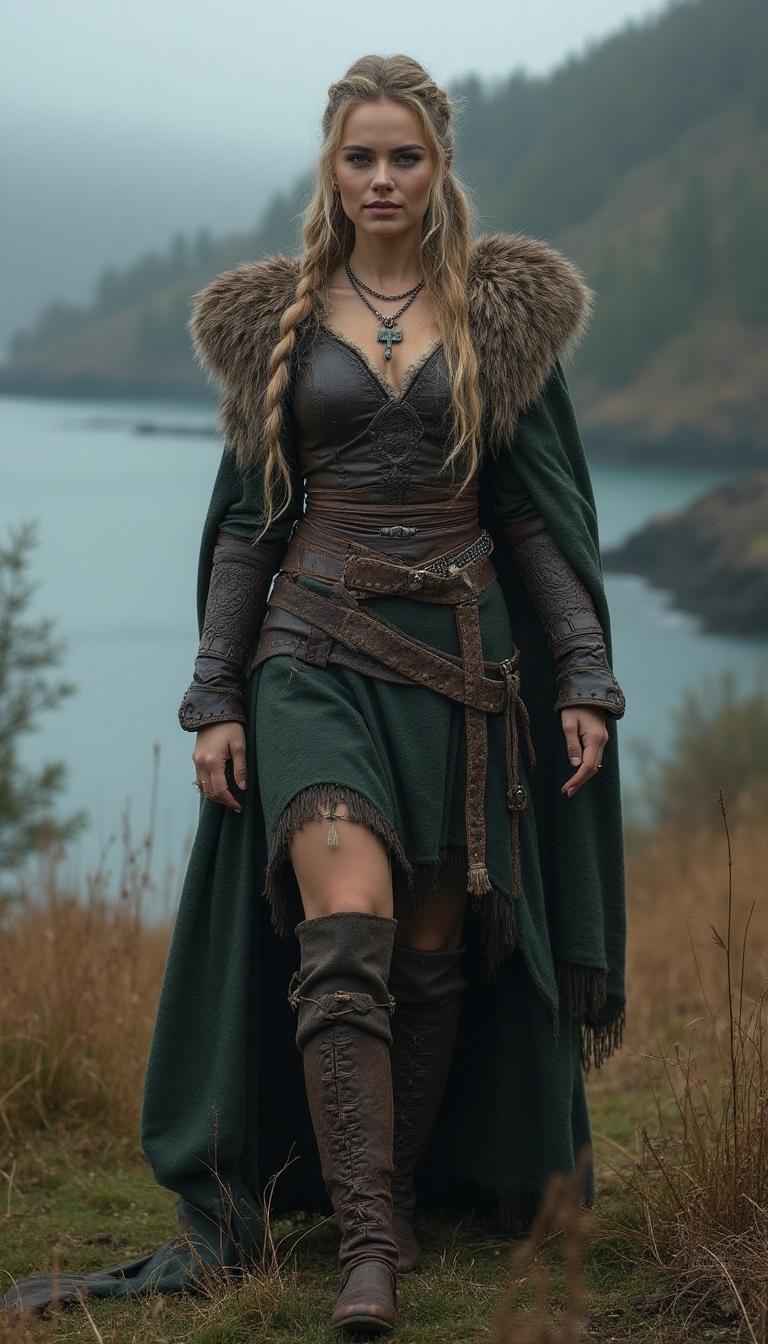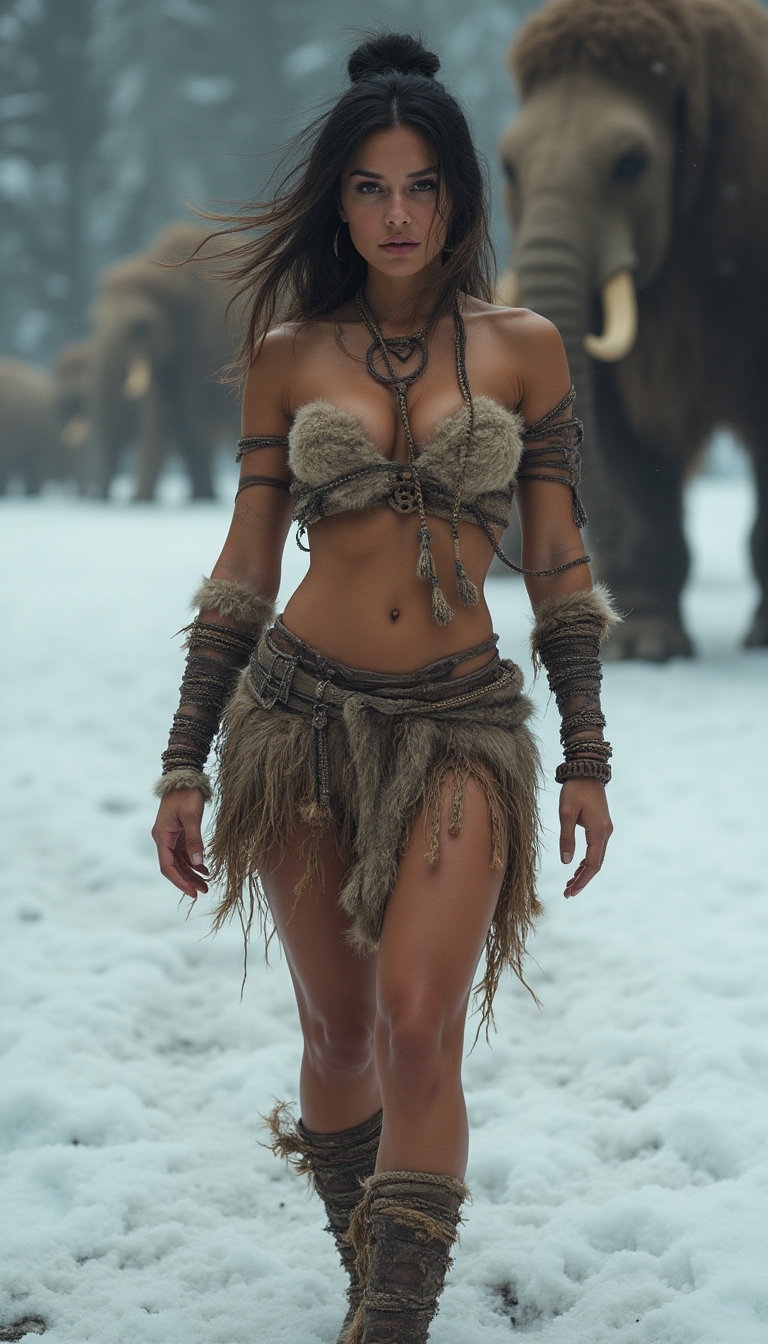Who Were Ice Age Hunter-Gatherers?
Ice Age hunter-gatherers lived in intimate harmony with the natural world, relying on foraging, hunting, and gathering to sustain their communities. Their way of life demanded sharp instincts, a deep knowledge of the land, and a profound respect for the forces of nature.
Far from primitive, these women were scientists, strategists, and healers. They navigated dense forests and open tundra, tracked animal migrations, foraged for edible roots and berries, and passed down wisdom through oral tradition. Their survival was not luck—it was mastery of an unforgiving environment.
A Day in the Life of an Ice Age Woman
Ayla Rouhan’s day begins long before the horizon glows with the pale blush of dawn. Rising from a bed of furs, she tightens the sinew ties on her leather boots and steps into the icy morning. Her breath forms clouds in the cold air, her eyes already scanning for signs of game or ripe plant growth.
Today, she plans to gather wild onions and scout for signs of reindeer. “One misstep out here can cost you everything,” she often reminds herself. The land demands awareness—not only of prey but of predators, weather shifts, and the unseen language of nature itself.
Her skills extend far beyond hunting. Ayla identifies medicinal plants by scent and shape, teaches younger clan members to track animals, and weaves nets and baskets from reeds and bark. Her role is multifaceted and vital—part warrior, part teacher, part guardian of ancient knowledge.
The Challenges Faced by Hunter-Gatherers
-
Mastering the Environment: The Ice Age world was vast, wild, and dangerous. Understanding local flora and fauna was a matter of survival. Every animal track, broken branch, or change in wind direction told a story only the trained could decipher.
-
Balancing Solitude and Community: Though they often traveled in groups, hunter-gatherers also endured long hours alone. Solitude offered space for reflection and alertness, but bonds with others—through shared food, fire, and song—offered emotional and physical security.
-
Cultural Legacy: For women like Ayla, survival wasn’t just personal—it was ancestral. Every movement was shaped by generations of accumulated knowledge. She felt the weight and pride of her lineage in every decision, every hunt, every footstep over frozen ground.
Ayla’s Philosophy: Nature as Ally and Teacher
Ayla often pauses to reflect beneath towering pine trees or beside the shimmering surface of a glacial stream. “Survivor, hunter, gatherer—these words aren’t labels. They’re a way of thinking, of being. Nature is not my enemy. It’s my teacher.”
This respect for the natural order governs every choice she makes. She takes only what is needed, leaves offerings in gratitude, and reads the land like an ancient book. Her relationship with nature is not one of dominance—but of dialogue.
Field Log Entry – A Glimpse into Ayla’s Thoughts
Tonight, I sit beneath the twisted limbs of a tree as old as stories. The roots twist into the earth like fingers grasping memory. The wind whispers through the branches, teasing my hair, hinting at change. I’ve heard that the caribou have moved east. The clan will need to follow.
Around my neck, I feel the weight of my mother’s mammoth bone necklace—a relic of strength, of survival. I remember her stories. I remember her laughter. And I wonder—what stories will they tell about me, when the snow has covered my tracks and all that remains is the echo of my path?
The Beauty and Complexity of the Hunter-Gatherer Life
In an era where survival meant confronting raw nature daily, Ice Age women like Ayla stood at the center of their communities. They were not only providers and protectors, but carriers of culture, memory, and meaning.
Their knowledge of seasonal cycles, animal behaviors, and healing herbs was encyclopedic. Their lives were hard, but not bleak—there was joy in the hunt, peace in shared meals, reverence in ritual, and resilience in the face of relentless cold.
What We Can Learn Today
Though millennia have passed, the principles embodied by Ice Age hunter-gatherer women still resonate:
-
Sustainability: Take only what is needed. Respect the balance.
-
Community: Share resources, wisdom, and strength.
-
Adaptability: Thrive not in spite of change, but because of it.
As we navigate our own uncertain future—marked by climate change, resource depletion, and shifting cultures—perhaps the greatest wisdom lies in looking backward. The way forward may be lit by the fire of ancient footprints.
Don’t forget to subscribe to our transmission and officially join the "Shining City on the Web". Like, share, challenge, or defend this narrative — let’s connect our stories across space and time.
Echoes in the Snow: The Story of Ayla Rouhan
1. Before the Wind
The wind came first.
It always did—brushing over the sleeping world, slipping between the bones of trees, whispering across stone and ice like an ancestor with stories to tell. Ayla Rouhan stirred beneath her fur cloak, the scent of fire-ash still clinging to her braids. She opened her eyes to darkness not yet broken by dawn and sat upright, her breath forming silent words in the air.
She stretched her legs, tightened the sinew cords of her boots, and stood. Her sleeping mat was bare rock dusted in moss and warmthless snow, but it was familiar. She had known colder beds.
She took a step and paused, her hand resting on the necklace of carved mammoth bone at her collarbone. It had belonged to her mother. To her mother’s mother. And now, Ayla wore it not as decoration—but as declaration.
“Today,” she whispered to the fire’s fading embers, “I will find them.”
2. The Scouting Path
The others were still asleep—Tariq, the flint-knapper; Veha, the fire singer; the children curled together under hides like pup-bears. Ayla left them, stepping over their shelter’s low entry, and into the cold.
Snow had fallen again in the night. Not much—just enough to erase yesterday’s footprints. The world beyond the camp was hushed, crystalline, a temple of frost. Ayla moved like a shadow between birch trunks, alert but unafraid.
She walked northeast, toward the valley where the wild onions sometimes pushed through thin ice-crusts. Her eyes caught the faint markings of a hare—tiny crescents in the powder. She read the story: late travel, eastbound, not frightened.
Her fingers brushed a patch of frozen lichen and she smiled. It had been stripped. Reindeer had passed here. Recently.
Her heart lifted. The herd was moving.
She squatted low near a stump, pressed her fingers into a crescent-shaped indentation. The shape of a hoof. Melted slightly from body heat. Hours old, she calculated. Maybe less.
They were close.
3. Firelight Memory
That night, after Ayla returned with news, the clan gathered around the fire. Smoke curled into the sky like a storyteller’s hand drawing a line across the stars.
Tariq passed Ayla a steaming bowl of marrow stew. “Will they pass through the east gorge again?” he asked.
Ayla nodded. “They will. Two nights, maybe three.”
“Then we must prepare the pitfall traps,” said Veha, the singer, her voice like crackling ice.
Later, Ayla took her stew to the edge of the circle and sat beneath a pine, the fire’s glow painting the snow orange. A child approached—little Suma, her hair tied with animal sinew.
“Will you tell a story?” Suma asked, her voice hopeful.
Ayla hesitated. “A true one,” she said finally. “Of when I almost died. But didn’t.”
Suma’s eyes widened.
Ayla spoke softly, so only the child would hear. “It was during the last hunger season. I was tracking elk along the cliff ridge. I slipped. One leg caught, the other dangled. Below me was the frozen river, hard as bone. I hung there for a long time. Called for help. None came.”
“What did you do?”
“I listened to the wind,” Ayla said. “And it reminded me—I was not the first to hang above death. My mother had. So had hers. I found a root in the rock, dug my fingers into it, and pulled. Inch by inch. Until the rock cut my hands and my legs shook.”
Suma stared. “And then?”
“I got back up.”
4. The Night the Sky Opened
Three nights later, they hunted.
The pitfall traps were hidden with branches and packed snow. Ayla crouched silently above them, her spear balanced in her hand. She could feel the tremors of hooves long before they came into view.
The reindeer moved like waves—shifting muscle and breath and instinct. One wrong movement could scatter them. One wrong gust of wind could betray the traps.
Ayla held her breath.
Then it happened.
The herd passed. The largest male stepped on the false snow. The branch snapped—he bellowed, legs scrambling—then he dropped.
The others scattered, a blur of fur and panic. But they had one. Enough meat for days.
Tariq raised his arms. The clan let out a cry of triumph. Ayla did not cry out. She stepped to the edge of the pit and looked down.
“Thank you,” she whispered to the beast. “You will feed our fire.”
Later that night, the aurora danced above them—ribbons of green and violet spreading across the stars like the arms of a spirit. Ayla stared upward for a long time, her lips parted.
“I saw my mother in the sky,” she told Veha quietly.
“She saw you too,” the old singer replied. “She watches.”
5. The Whispering Grove
In the weeks that followed, the weather turned. Wind rose sharp and hungry. The clan packed to move—east, following the herds and the warmth.
Ayla scouted ahead.
She traveled alone for three days, crossing frozen rivers, blackened forest, and wide plains where silence reigned. On the fourth day, she reached the grove—an ancient place where trees stood older than stories and the air smelled of moss and memory.
There, she knelt and placed her hand on the earth.
“I am Ayla Rouhan,” she said aloud, as was tradition. “Daughter of Dena. Of the Stone-Faced People. I come seeking passage.”
The wind shifted.
She waited.
Then—faint, but unmistakable—she heard it: the low grunt of caribou.
She turned, rose, and ran.
6. Echoes of the Future
Years passed.
Ayla became a matriarch. A storyteller. A scout for the young. She taught Suma how to read a bird’s flight for storm warnings, how to dig for buried bulbs in snow, how to braid a sling from bark fiber.
She no longer hunted as often. But the fire she carried had not dimmed.
On her final night, she returned to the grove. Alone.
She sat beneath the great tree and opened her pouch. Inside: a smooth stone, a mammoth tooth, a dried herb, and a new carving—a tiny image of a woman standing in the wind.
She placed the items beneath the roots.
“My name is Ayla Rouhan,” she whispered to the darkness. “I was hunter. Healer. Teacher. I was wind and flame. Let my name travel in the snow.”
And when she closed her eyes, the wind rose gently through the branches—telling her story before the snow came to cover her footprints.
Epilogue: What We Remember
The Ice Age gave no mercy. But those who lived through it did not seek mercy. They sought meaning. Balance. Connection.
Ayla Rouhan did not build empires or carve monuments.
But she passed down wisdom in the scent of cedar, the twist of rope, the hush of snow between pines.
She taught that to survive is not to dominate—but to understand.
And in her footprints, we still walk.
Disclaimer: This article may contain affiliate links. If you click on these links and make a purchase, we may receive a commission at no additional cost to you. Our recommendations and reviews are always independent and objective, aiming to provide you with the best information and resources.
Get Exclusive Stories, Photos, Art & Offers - Subscribe Today!

























Post Comment
You must be logged in to post a comment.